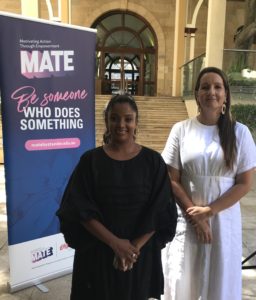Griffith University’s MATE Bystander Program is highly effective in empowering people to actively contribute to eliminating violence and coercive control, an evaluation by the Australian Council for Educational Research (ACER) has found.
More than three in five participants surveyed since taking part in the Motivating Action Through Empowerment (MATE) Bystander Program had since become active bystanders by intervening when they saw, heard or sensed something wasn’t okay.

MATE Bystander Program Directors Anoushka Dowling and Shaan Ross-Smith.
The ACER evaluation, commissioned by Griffith University in November 2021, found the program to be highly effective at equipping people with the tools and understanding to step in and address problematic behaviour, prevent violence against women, racism and discrimination, and promote equality.
MATE Bystander Program Directors Shaan Ross-Smith and Anoushka Dowling said they were proud of the results of the evaluation.
“Our program empowers participants to become leaders and active bystanders in the community to prevent violence,” Ms Ross-Smith said.
“We challenge the root attitudes, beliefs and behaviours that normalise violence against women, inequality, racism, discrimination and bullying within our society.”
“We are proud that the results of this ACER evaluation show we are successful in achieving the objectives of MATE Bystander Program,” Ms Dowling said.
ACER researchers surveyed 76 participants in Train the Trainer sessions and interviewed 10 key stakeholders, including program staff and relatives of those killed by their partners, four facilitators and 10 prior program participants. Griffith also provided feedback collected from 569 program participants.
MATE Bystander Program highlighted four main objectives for evaluation:
- Increasing awareness of the cultural basis for abuse.
- Enhancing the ability to recognise potentially harmful environments and problematic situations.
- Encouraging bystanders to feel empowered to effectively interrupt problematic behaviour.
- Providing bystanders with tools and understanding to help prevent problematic behaviour.
ACER Research Director Sarah Richardson said 90 per cent of respondents reported feeling more confident about intervening to stop problematic behaviour after the program.
“We found more than three in five survey respondents have become active bystanders since participating in the program,” Dr Richardson said.
“This action ranged from making their home or community more equal to speaking to someone about their problematic behaviour.
“Half of survey respondents had directly intervened to stop problematic behaviour.”
More than 95 per cent of prior participants reported better understanding the necessity of bystander action to prevent violence against women, while between 88 and 100 per cent reported knowing what to do when confronted by a difficult situation.
Eighty-eight per cent of survey participants reported having discussed issues included in the program with their friends or family, with a 74 per cent increase in the proportion who ‘knew a lot’ after the workshop.
Almost all (92 per cent) survey respondents reported the program helped them to better recognise problematic situations. More than 60 per cent of respondents, who had since facilitated training themselves, reported they had been approached by colleagues wanting to learn more and have seen or heard about people in their organisation becoming active bystanders.
“It is unusual to evaluate a program for which there is such consistent support and positive feedback, and which is so clearly achieving its objectives,” Dr Richardson said.
“We were really impressed by the extent to which program participants reported being profoundly positively impacted by their involvement.”

